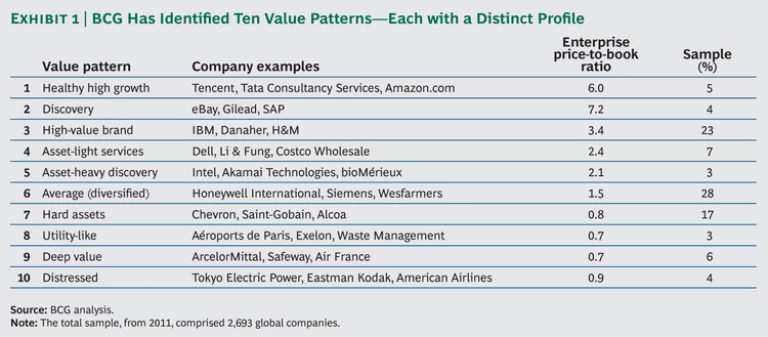The test of a successful strategy is whether it creates sustainable value over time. The appropriate pathway and relevant priorities, however, will be different for, say, a Google, a Gazprom, a Gilead, or a General Dynamics. How does a company’s senior team develop a value creation strategy that truly fits the company’s starting position and opportunity set?
The 2012 Value Creators Report
The Idea of a Value Pattern
Although the details of each company’s situation are unique, there are recurring common starting positions—combinations of economic priorities, tradeoffs, opportunities, and risks—in which different groups of companies find themselves. BCG has been exploring how to quantify these starting positions. In-depth discussions with professional investors, detailed company vignettes, and a statistical clustering of about 2,700 global companies have led us to identify ten different value patterns —distinctive company starting positions that cut across industry boundaries and shape the range and types of strategic moves most likely to create value. (See “BCG Research on Value Patterns” below.)
BCG Research on Value Patterns
Since 2010, BCG’s Corporate Development practice has been conducting research on company value patterns. Our research has focused on the S&P 1200—a group of large, publicly traded, nonfinancial U.S. corporations—in the time period from 2002 through 2011.
We profiled each company’s starting position by measuring six dimensions of company performance that interviews with institutional investors had emphasized as being critical for defining different investment types.
After testing many distinct input variables, we decided to focus on the following ten key metrics within those six critical dimensions:
- Business model economics, as reflected in a company’s value added (measured by gross margin), capital intensity (measured by capital per dollar of sales), R&D intensity (measured by R&D expenditures as a percentage of sales), and operating-expenditure intensity (measured by operating expenditures as a percentage of sales)
- Financial health, as measured by return on tangible gross investment
- Growth exposure, as measured by analysts’ consensus estimates of a company’s forward-looking three- to five-year revenue growth
- Investor expectations and valuation, as measured by a company’s enterprise price-to-book ratio and equity price-to-revenue ratio
- Commercial risk, as measured by a company’s 100-month median enterprise-value volatility
- Financial risk, as measured by a company’s ratio of net debt to enterprise market value
When we calculated return on investment (ROI) and capital intensity, we excluded cash balances from the capital base, because cash, which doesn’t earn any return, distorts a company’s profitability. Since data coverage was not complete for all companies in all years, our final sample consisted of between 850 and 900 companies, depending on the year of analysis.
To sort the companies into groups with common starting positions, we used a statistical clustering tool. The tool uses algorithms to cluster companies so that both the similarities among companies in a given group and the differences between groups are maximized. We then tested the resulting groups for robustness (consistency of group profile over time) using data from 2002, 2007, 2009, and 2011 in independent clustering analyses. To eliminate survivor bias, the data sets included all S&P 1200 companies with complete data in each given year.
Ten consistent groups—or value patterns—emerged from this statistical clustering process. We used these ten group profiles to assign a global sample of 3,900 companies across 61 countries to each of the ten value patterns. Working across countries, we excluded the imapct of currency inflation on forward revenue growth rates by restating the growth in “real” terms.
In the course of our research, we experimented with other dimensions and variables to characterize a company’s profile—for example, dividend payout, dividend yield, earnings predictability, earnings consistency, ROI volatility, beta, and company size. We found that such variables caused the clusters to become unstable over time or to mix companies with clearly different investment challenges in the same segment. What’s more, we found that dropping any of the ten key metrics noted above degraded the results in a similar fashion.
Our research on value patterns remains preliminary, and we will be continuing our analyses. In particular, we intend to explore the dynamics of value patterns in specific industries and to work with companies as well as investors to identify practical applications of our value-pattern research to corporate and portfolio strategies and to M&A.
Some of these value patterns are fairly intuitive and easy to grasp. For example, distressed companies (roughly 4 percent of the companies in our sample) have a specific and easy-to-recognize profile. They have high debt levels and severe constraints on liquidity. They often face external headwinds that result in low or negative returns on capital and negative organic-growth rates. Investors, recognizing these companies’ high risk and poor reinvestment economics, value them at low multiples—typically, the market values the enterprise at a discount to its book capital.
At the other end of the spectrum, there is a healthy high-growth value pattern that most people recognize immediately. This pattern (seen in about 5 percent of the companies in our sample) captures the challenges faced by healthy and successful companies that are still relatively young and growing rapidly (such as the pure-play category innovators Chipotle Mexican Grill and Intuitive Surgical). Their business is expected (and also priced by investors) to double sales several times over in the next five to ten years. Investors, seeing the strong prospects of these companies, value them at high multiples, often in the range of four to eight times enterprise book capital.
Most companies fall somewhere between these two extremes. Exhibit 1 lists the ten value patterns we have identified in our research. About three-fourths of all companies have some starting-position “spikiness” that differentiates them from the average company. These value patterns are distinctive, and to an outside observer—such as a professional investor—they suggest clear priorities for competitive success and value creation. About one in four companies, however, has a starting position that we call average (diversified). These companies have characteristics close to the average company in our sample. Instead of being able to focus on two or three clear issues in their investment thesis, they have to take a more balanced approach.
Value patterns share four general characteristics. First, they cut across industry boundaries. Each includes companies from quite different industries. And companies within a single industry may have quite distinct value patterns. Second, each group’s profile is relatively stable over time—although individual companies sometimes move between groups. Third, capital structure, dividend payout, and other financial policies tend to differ by group. So do the tradeoffs between growth and margins, the pattern of “unlocks” (that is, the major value-creating moves), and the key pitfalls (that is, the ways companies in each group tend to destroy value). Finally, each of the patterns has distinct drivers of valuation multiples, and a few of the groups attract particular types of professional investors that specialize in that value pattern and have distinct screening criteria and metrics of interest.
Clustering together companies from different industries may seem strange. But it is an approach that corresponds to how many hedge funds, private-equity groups, and other professional investors look at businesses, and it can be extremely useful for a company’s senior team as well. To understand why, let’s look in detail at the stories of two companies that won spots in this year’s Value Creator rankings.
Kansas City Southern and FMC Technologies are two U.S. companies in our Value Creators database. In the five-year period from 2007 through 2011, they both delivered enough average annual TSR (19 percent and 28 percent, respectively) to be listed in the top-ten rankings in their industries. And yet, each company did so in a different way, reflecting different starting positions and the priorities of different value patterns.
How a Hard-Assets Company Created Value
Kansas City Southern (KCS) is the smallest of the Class 1 railroad operators in the U.S. The company has a focused market position in the central and south-central part of the country, as well as a strong position in Mexico through its subsidiary, KCS de Mexico. In 2006, KCS had the oldest fleet in the industry, high debt leverage (with a debt-to-enterprise-value ratio of 44 percent), and a high cost structure relative to its peers. And yet, over the next five years, it delivered an average annual TSR of 19 percent, earning it the number four position in our global transportation and logistics rankings.
How exactly did KCS create superior shareholder value during the period we studied? In 2006, the company’s starting position fit the hard assets value pattern. These are businesses whose economics reflect high capital intensity (typically, the historical investment in capital employed for the companies in this group is substantial, in the neighborhood of two to three times annual revenues), meaningful debt leverage, mature (and sometimes cyclical) demand, and modest returns on capital. Hard-asset companies cross many different industries, but businesses commonly found in this value pattern include integrated oil, telecommunications, mining, asset-heavy hospitality, and railroads.
Such businesses have distinct priorities for value creation. First, they need to drive ROI through effective productivity improvements and consolidate their assets to reap cost and capacity efficiencies. Second, they must make sure that their reinvestment bets, which are highly capital intensive, truly contribute to the competitive advantage of the business and take into account the cyclicality of demand. Third, they must do all this while managing debt leverage and balance sheet risk. The strategies pursued by KCS in recent years dramatically illustrate these three priorities.
Drive return on capital through improved productivity. The company aggressively improved its operational efficiency, reducing its operating ratio (total expenses as a percentage of revenue) from 82 percent in 2006 to 73 percent in 2011. In response to the 2008–2009 economic crisis, KCS conducted a comprehensive operational review and redesigned processes to significantly reduce structural cost. And it used some of the savings to refresh its fleet, which greatly improved efficiency and contributed to additional savings over the long term. These initiatives, combined with the capacity investments described below, drove more than 200 basis points of improvement in ROI from 2006 through 2011.
Invest in advantaged capacity bets. But KCS didn’t just cut costs and run its existing network more efficiently. The company also invested heavily in a clear strategic vision: to create new routes and new capacity in a network supporting trade between Asia and North America and between Mexico and the U.S. As a result of long-term growth in Pacific container traffic, the ports of Los Angeles and Long Beach, California, key entry points for Asian imports, have become increasingly congested. To create a viable alternative, KCS has been investing heavily in its Mexican rail network. For example, during the past decade, the company has been building an intermodal facility at the port of Lazaro Cardenas on Mexico’s west coast. KCS has exclusive rail access to the port, which provides an attractive alternative to shippers that are bringing containers from Asia into North America, both for the domestic Mexican market and for further shipment on to the U.S.
In parallel, the company invested in building the most direct route into the U.S. from Mexico at Laredo, Texas, connecting to its network in Houston and beyond. The new line and other major initiatives to improve service and reduce the cost of freight coming from Mexico to the U.S. have made railroad shipping far more competitive with truck shipping and enabled the shift of U.S.-Mexico traffic from trucks to trains. This capability allows KCS to capitalize on growing industrial production in Mexico, especially in the automotive supply chain.
By offering valuable new options for customers and by positioning itself to benefit from the increasing economic growth in and trade with both Mexico and Asia, KCS has been able to improve its EBITDA (earnings before interest, taxes, depreciation, and amortization) margin from 28 percent in 2006 to 37 percent in 2011.
Derisk the balance sheet. The 2005 acquisition of its Mexican joint-venture partner left KCS with relatively high financial leverage and limited liquidity (only $31 million in cash on hand). Even as it was investing heavily in network upgrades and new capacity, KCS took action to strengthen its balance sheet, reducing its economic leverage by taking its net debt-to-enterprise value down from 44 percent in 2006 to 20 percent by 2011. As a sign of this progress, the company’s credit rating was upgraded during this period from B to BB+. The combination of refinanced liabilities and a better credit rating increased the company’s financial flexibility—and even allowed KCS to initiate a common dividend in early 2012.
Taken together, all these moves allowed KCS to deliver its superior TSR through a balanced mix of revenue growth (responsible for 5 percentage points of annual TSR), margin expansion (responsible for 6 percentage points), improvements in the company’s valuation multiple (responsible for 7 percentage points), and free-cash-flow yield (responsible for about 1 percentage point).
Lessons from an Industrial High-Value Brand
FMC Technologies is a leading global provider of technology solutions for the oil and gas industry. The company is the market leader in technologically sophisticated systems for deep-water subsea production and processing. In the five years from 2007 through 2011, FMC Technologies delivered an average annual TSR of 28 percent—an extraordinary performance and good enough for the number five position in our global machinery industry rankings. In 2012, FMC Technologies was named “the world’s most admired oil and gas equipment, service company” by Fortune magazine .
How did FMC Technologies deliver this outcome? In 2006, the starting position of FMC Technologies fit the value pattern that we call high-value brand . Companies in this value pattern are among the healthiest and strongest businesses in the market. They typically enjoy powerful competitive advantages in relatively mature and stable markets. They have proprietary, differentiated products with high value added. They enjoy low capital intensity (50 cents in capital for every dollar in revenue), low debt leverage, stable growth in demand, and high returns on capital. High-value-brand companies are healthy category leaders with attractive business economics, and they are found across many industries. Among the companies in this year’s Value Creators rankings that fit this value pattern are IBM, McDonald’s, and Perrigo.
And yet, despite so healthy a starting position, high-value-brand companies do not necessarily create more shareholder value on average than the market as a whole. In any given period, there are clear winners in the group that deliver top-quartile returns and also clear losers that deteriorate and end up destroying value.
What’s more, the typical unlocks associated with top-quartile performance from a high-value-brand starting position are rather different from those discussed for hard-asset companies. In this value pattern, companies need to protect and grow the core category. They need to fight pressures toward commoditization by continually investing in competitive differentiation. They need to avoid low-quality growth that comes at the price of eroding margins. And, finally, they need to carefully allocate excess cash—either by reinvesting it in the portfolio at greater than a dollar in risk-adjusted present value or by returning it to shareholders as a yield-based contribution to TSR.
Protect and grow the core category. FMC Technologies is a clear market leader in subsea infrastructure (the equipment used to exploit deep-water offshore oil and gas deposits). Its products play a critical role in enabling advances in safe and effective deep-water production.
As the world’s mature onshore oil and gas fields are gradually depleted, there is a growing demand for new and improved approaches to deep-water production. But deep-water development is an extraordinarily expensive and technically difficult proposition. For example, since 2007, Petrobras, Brazil’s national oil company, has discovered several large offshore fields more than 150 miles from land and more than 3 miles below the water’s surface. The company recently announced that it expects to spend more than $125 billion over the next five years to develop these offshore deposits. The financial and technical risks involved in these projects are significant, and oil companies increasingly depend on partners such as FMC Technologies to supply critical systems and solutions.
FMC Technologies has a long history of supporting category growth in deep-water exploration. The company holds many deep-water drilling records and has continued its intense focus on improving its customers’ economics by providing technically superior solutions to enhance oil recovery. For example, in 2011, FMC Technologies completed its Marlim project, a $90 million subsea processing complex for Petrobras, designed to set new industry standards for mature-field deep-water oil-water separation and reinjection of water into a subsea reservoir to boost production.
Reinvest to fight commoditization. From 2008 through 2011, FMC Technologies doubled its R&D investment and entered into new technology-licensing agreements in order to maintain its technical leadership and to capitalize on the growing demand for deep-water oil and gas production. These steps have made the company a leader in subsea separation boosting and processing systems, a new technology used to increase oil recovery in mature fields and to develop new fields that had previously been too expensive to exploit. The company also completed a series of bolt-on acquisitions to add capabilities such as robotics for remotely operated vehicle systems, permanent magnet motors to power pumps, and self-adjusting high-accuracy meters suited for permanent monitoring of deep-sea wells. Innovation—whether developed internally or acquired from outside—has kept the company at the forefront of its sector.
Avoid low-quality growth and deploy capital carefully. The company also managed its capital bets to concentrate resources in its most advantaged areas. While adding technology-enhancing acquisitions, FMC Technologies also focused its portfolio with the 2008 spinout of non-oil-related equipment businesses. The combination of organic growth, acquisition, and divestment resulted in expanded gross margins and higher return on capital, each of which increased by 200 basis points.
Taken together, these moves allowed FMC Technologies to deliver its superior TSR through a balanced mix of revenue growth (responsible for 6 percentage points of annual TSR), margin expansion (responsible for an additional 6 percentage points), improvements in the company’s valuation multiple (responsible for 13 percentage points), and free-cash-flow yield (responsible for 2 percentage points).
Value patterns do not offer a one-size-fits-all prescription or strategy cookbook. The strategic agenda for any particular company will be highly specific to its particular situation and will reflect critical issues not captured by this kind of outside-in view of a company’s starting position. Nevertheless, because it identifies the types of actions that are more likely to create value, a company’s value pattern is an essential input that helps inform the strategic agenda. Knowing your value pattern won’t necessarily tell you what to do, but it will tell you where to look—and where the better odds are for value creation success.










